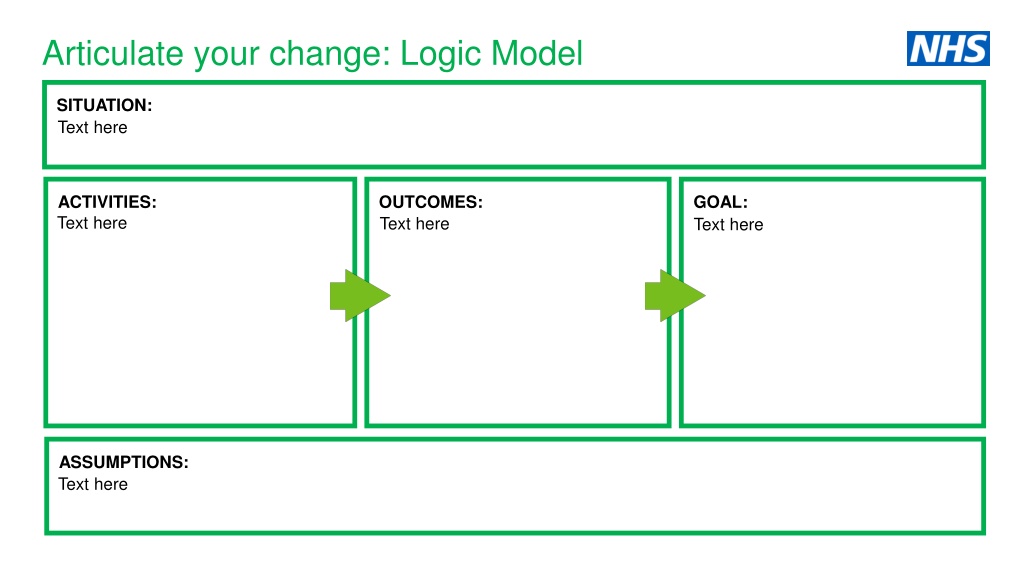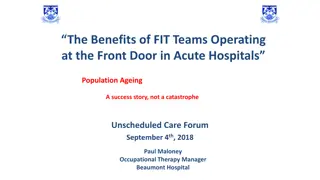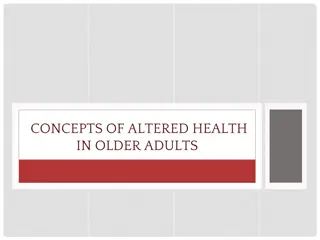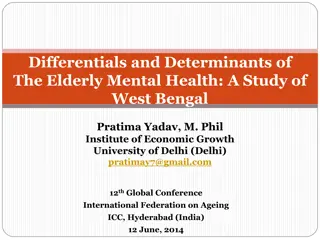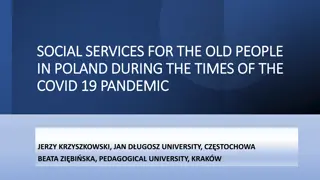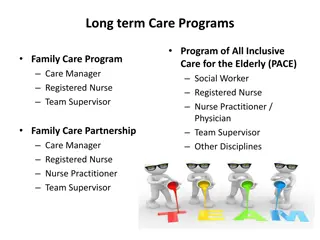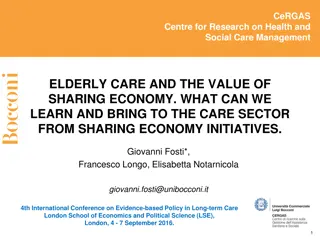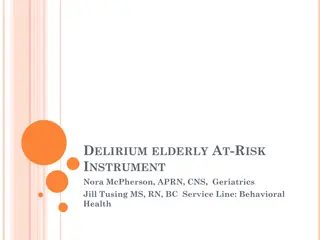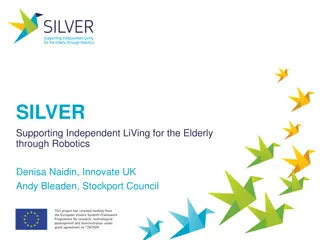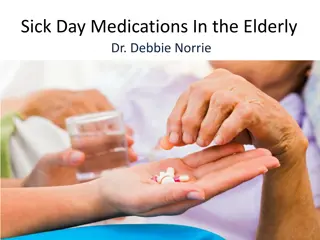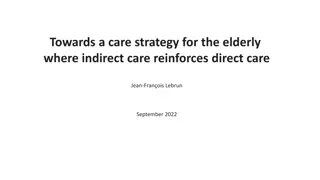Transforming Elderly Care: A Logic Model Approach
A logic model is applied to maximize health and well-being for frail elderly individuals by addressing inequality in care provision, inefficiencies, financial pressures, and over-reliance on in-patient care. Activities focus on early intervention, coordinated care delivery, and joint budgeting, resulting in faster, more consistent care, increased choice and control for recipients, improved collaboration, and reduced avoidable admissions. The goal is to ensure all frail elderly receive appropriate care when needed, supported by assumptions of resource realignment and cultural change.
Download Presentation

Please find below an Image/Link to download the presentation.
The content on the website is provided AS IS for your information and personal use only. It may not be sold, licensed, or shared on other websites without obtaining consent from the author. Download presentation by click this link. If you encounter any issues during the download, it is possible that the publisher has removed the file from their server.
E N D
Presentation Transcript
Articulate your change: Logic Model SITUATION: Text here ACTIVITIES: Text here OUTCOMES: Text here GOAL: Text here ASSUMPTIONS: Text here
Articulate your change: Maximise health & well-being for frail elderly (logic model) SITUATION: Inequality in provision of care and wide variation in quality of care Fragmented health and care system and inefficiencies Health organisations and local Authorities are under financial pressures Over dependence on in-patient care - high number of avoidable admissions ACTIVITIES: Early intervention & proactive support Person centred & planned care delivery Coordinated care across health, social care & mental health Joint approaches to budgets & contracts Ready access to community-based care OUTCOMES: Faster, more consistent care across the local system Increased choice and control over own health & care needs Improved collaboration & coordination of care Improved experience of care Reduced avoidable admissions, A&E visits etc. Reduced overall cost of care & support GOAL: All the frail elderly living in the area receive the most appropriate care and support they need in the right place and at the right time ASSUMPTIONS: There will be a realignment of resources as stakeholders work together; Cultural change takes place; There are national levers to support the programme; Partners will have freedom to implement changes to work differently.
Articulate your change: Narrative Your programme Your Programme Once upon a time Every day One day Because of that Because of that Until finally
Articulate your change: Narrative Your programme Your Programme There was inequality in provision of care and wide variation in quality of care. A fragmented health and care system and inefficiencies led to duplication; inadequate collaboration and coordination of care. Once upon a time Health organisations and local authorities struggle with financial pressures and there is an over dependence on in-patient care with high numbers of avoidable admissions. Every day A group decides to work together to apply the principles of large scale change to tackle the problems. One day We achieve improved collaboration and greater coordination of care needs, which leads to faster, more consistent care across the local system. Service users experience increased choice and control over own health and care needs. Because of that We see improved experience of care and support. There is a reduction in voidable admissions, A&E visits etc. This leads to a reduction in overall cost of care and support and a more productive health economy. Because of that People with or at risk of developing complex care needs receive the most appropriate care and support they need in the right place and at the right time. Until finally
Articulate your change: Driver diagram Secondary driver Activities or interventions Primary driver Secondary driver Activities or interventions Activities or interventions Secondary driver Key aim or outcome Primary driver Activities or interventions Secondary driver Activities or interventions Secondary driver Activities or interventions Primary driver Secondary driver Activities or interventions
Articulate your change: Maximise health & well-being for frail elderly (driver diagram) Person centred & planned care delivery Personalised care plans available for all Increased choice and control over own health & care needs Coordinated care across health, social care & mental health All the frail elderly living in the area receive the most appropriate care and support they need in the right place and at the right time Improved experience of care Ready access to community-based care Faster, more consistent care across the local system Early intervention & proactive support Improved signposting to community-based services Joint approaches to budgets & contracts Reduced avoidable admissions, A&E visits etc. Reduced overall cost of care & support
Articulate your change: 30, 60, 90 day plan Activity & outcome Activity & outcome Activity & outcome Activity & outcome Activity & outcome Activity & outcome Activity & outcome Activity & outcome Activity & outcome Activity & outcome Activity & outcome Activity & outcome Activity & outcome Activity & outcome Activity & outcome
Articulate your change: 30, 60, 90 day plan Improve signposting to community based services reduced A&E admissions Early intervention & proactive support reduced A&E admissions Person centred & planned care delivery improved experience of care Joint approaches to budgets improved collaboration and co- ordination of care
Choose measures Evidence of.. Activity/outcome/goal/ assumptions? Measure How will you measure it? Priority Rationale Why choose this measure? Issues or limitations
Choose measures Evidence of.. Activity/outcome/goal/ assumptions? Measure How will you measure it? Priority Rationale Why choose this measure? Issues or limitations High Outcome - Reduction in overall cost of care and support Cost / number of admissions or attendances, ambulance transmissions, ongoing social care packages, practice nurse contracts, GO contracts, OoH GP contracts, Age UK and other volunteer intervention Must have - Include all end-to end costs to understand overall cost. High priority key to sustainable service Cost data from various sources, varying time-frames. Medium Outcome - Improved experience of care and support Adapted Friends and Family test for patients and staff Should have faster and more appropriate care should have improved the patient experience. Well known and understood tool, easy to roll-out Test is very simple some aspects of care may be good and others not so good, difficult for people to score complex care and services GP patient survey GP patient survey is already carried out nationally no cost to use Good data, but slow in getting results High Provision of person centred, planned and proactive care and support Proportion of cohort with person centred care plan in place (social or health care or both) Should have shows evidence of new activity to support frail elderly. Definitions of care plans in health and social care, data available. Is there a desired target value would we want 100% of cohort to have a plan?
